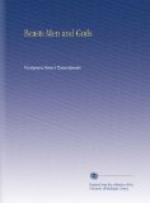The second class is the doctors or “Ta Lama.” They observe the actions of plants and certain products from animals upon people, preserve Tibetan medicines and cures, and study anatomy very carefully but without making use of vivisection and the scalpel. They are skilful bone setters, masseurs and great connoisseurs of hypnotism and animal magnetism.
The third class is the highest rank of doctors, consisting chiefly of Tibetans and Kalmucks—poisoners. They may be said to be “doctors of political medicine.” They live by themselves, apart from any associates, and are the great silent weapon in the hands of the Living Buddha. I was informed that a large portion of them are dumb. I saw one such doctor,—the very person who poisoned the Chinese physician sent by the Chinese Emperor from Peking to “liquidate” the Living Buddha,—a small white old fellow with a deeply wrinkled face, a curl of white hairs on his chin and with vivacious eyes that were ever shifting inquiringly about him. Whenever he comes to a monastery, the local “god” ceases to eat and drink in fear of the activities of this Mongolian Locusta. But even this cannot save the condemned, for a poisoned cap or shirt or boots, or a rosary, a bridle, books or religious articles soaked in a poisonous solution will surely accomplish the object of the Bogdo-Khan.
The deepest esteem and religious faithfulness surround the blind Pontiff. Before him all fall on their faces. Khans and Hutuktus approach him on their knees. Everything about him is dark, full of Oriental antiquity. The drunken blind man, listening to the banal arias of the gramophone or shaking his servants with an electric current from his dynamo, the ferocious old fellow poisoning his political enemies, the Lama keeping his people in darkness and deceiving them with his prophecies and fortune telling,—he is, however, not an entirely ordinary man.
One day we sat in the room of the Bogdo and Prince Djam Bolon translated to him my story of the Great War. The old fellow was listening very carefully but suddenly opened his eyes widely and began to give attention to some sounds coming in from outside the room. His face became reverent, supplicant and frightened.
“The Gods call me,” he whispered and slowly moved into his private shrine, where he prayed loudly about two hours, kneeling immobile as a statue. His prayer consists of conversation with the invisible gods, to whose questions he himself gave the answers. He came out of the shrine pale and exhausted but pleased and happy. It was his personal prayer. During the regular temple service he did not participate in the prayers, for then he is “God.” Sitting on his throne, he is carried and placed on the altar and there prayed to by the Lamas and the people. He only receives the prayers, hopes, tears, woe and desperation of the people, immobilely gazing into space with his sharp and bright but blind eyes. At various times in the service the Lamas




